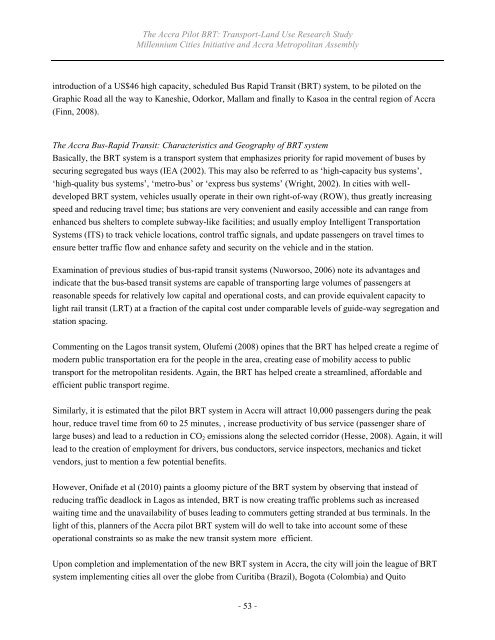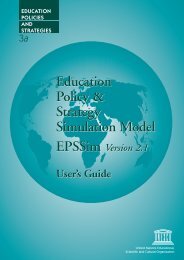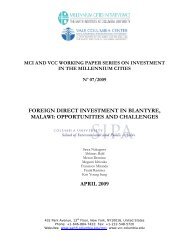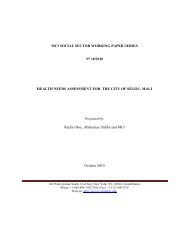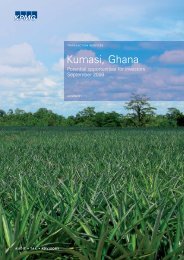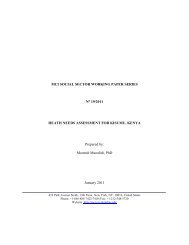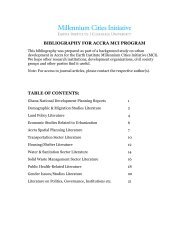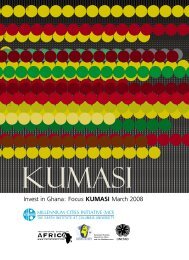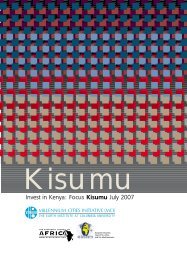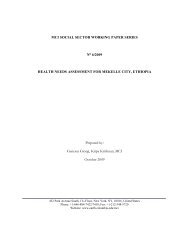Transport-Land Use Research Study - Millennium Cities Initiative ...
Transport-Land Use Research Study - Millennium Cities Initiative ...
Transport-Land Use Research Study - Millennium Cities Initiative ...
Create successful ePaper yourself
Turn your PDF publications into a flip-book with our unique Google optimized e-Paper software.
The Accra Pilot BRT: <strong>Transport</strong>-<strong>Land</strong> <strong>Use</strong> <strong>Research</strong> <strong>Study</strong><br />
<strong>Millennium</strong> <strong>Cities</strong> <strong>Initiative</strong> and Accra Metropolitan Assembly<br />
introduction of a US$46 high capacity, scheduled Bus Rapid Transit (BRT) system, to be piloted on the<br />
Graphic Road all the way to Kaneshie, Odorkor, Mallam and finally to Kasoa in the central region of Accra<br />
(Finn, 2008).<br />
The Accra Bus-Rapid Transit: Characteristics and Geography of BRT system<br />
Basically, the BRT system is a transport system that emphasizes priority for rapid movement of buses by<br />
securing segregated bus ways (IEA (2002). This may also be referred to as „high-capacity bus systems‟,<br />
„high-quality bus systems‟, „metro-bus‟ or „express bus systems‟ (Wright, 2002). In cities with welldeveloped<br />
BRT system, vehicles usually operate in their own right-of-way (ROW), thus greatly increasing<br />
speed and reducing travel time; bus stations are very convenient and easily accessible and can range from<br />
enhanced bus shelters to complete subway-like facilities; and usually employ Intelligent <strong>Transport</strong>ation<br />
Systems (ITS) to track vehicle locations, control traffic signals, and update passengers on travel times to<br />
ensure better traffic flow and enhance safety and security on the vehicle and in the station.<br />
Examination of previous studies of bus-rapid transit systems (Nuworsoo, 2006) note its advantages and<br />
indicate that the bus-based transit systems are capable of transporting large volumes of passengers at<br />
reasonable speeds for relatively low capital and operational costs, and can provide equivalent capacity to<br />
light rail transit (LRT) at a fraction of the capital cost under comparable levels of guide-way segregation and<br />
station spacing.<br />
Commenting on the Lagos transit system, Olufemi (2008) opines that the BRT has helped create a regime of<br />
modern public transportation era for the people in the area, creating ease of mobility access to public<br />
transport for the metropolitan residents. Again, the BRT has helped create a streamlined, affordable and<br />
efficient public transport regime.<br />
Similarly, it is estimated that the pilot BRT system in Accra will attract 10,000 passengers during the peak<br />
hour, reduce travel time from 60 to 25 minutes, , increase productivity of bus service (passenger share of<br />
large buses) and lead to a reduction in CO2 emissions along the selected corridor (Hesse, 2008). Again, it will<br />
lead to the creation of employment for drivers, bus conductors, service inspectors, mechanics and ticket<br />
vendors, just to mention a few potential benefits.<br />
However, Onifade et al (2010) paints a gloomy picture of the BRT system by observing that instead of<br />
reducing traffic deadlock in Lagos as intended, BRT is now creating traffic problems such as increased<br />
waiting time and the unavailability of buses leading to commuters getting stranded at bus terminals. In the<br />
light of this, planners of the Accra pilot BRT system will do well to take into account some of these<br />
operational constraints so as make the new transit system more efficient.<br />
Upon completion and implementation of the new BRT system in Accra, the city will join the league of BRT<br />
system implementing cities all over the globe from Curitiba (Brazil), Bogota (Colombia) and Quito<br />
- 53 -


